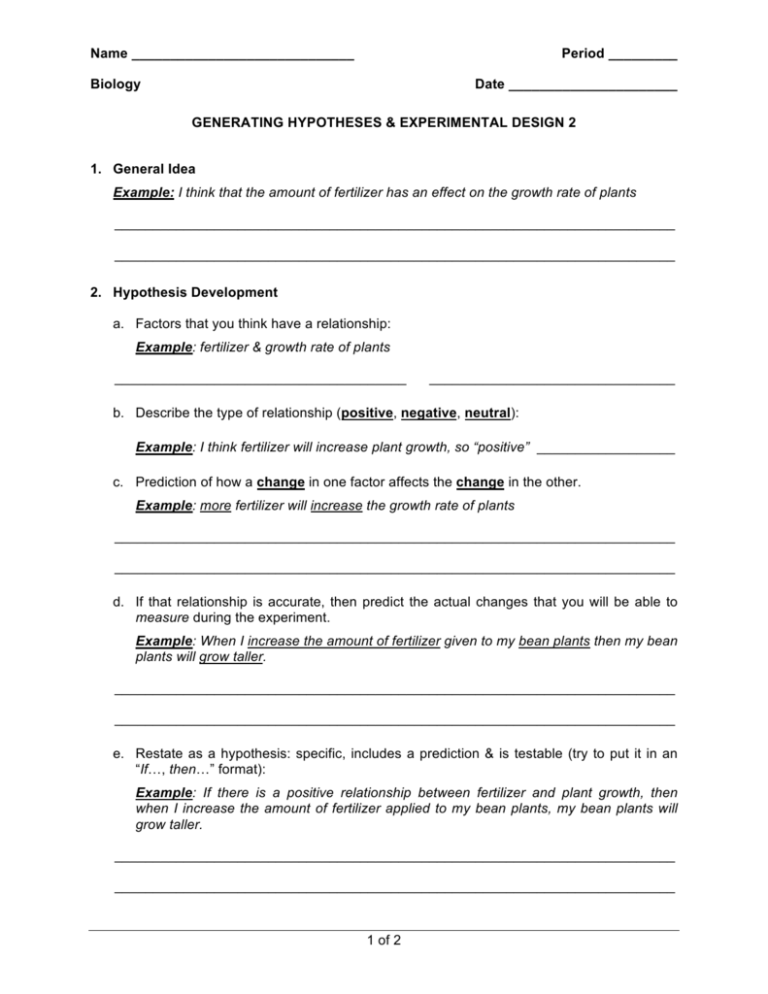Name Period ______ Biology Date 1 of 2 GENERATING
advertisement

Name _____________________________ Period _________ Biology Date ______________________ GENERATING HYPOTHESES & EXPERIMENTAL DESIGN 2 1. General Idea Example: I think that the amount of fertilizer has an effect on the growth rate of plants _________________________________________________________________________ _________________________________________________________________________ 2. Hypothesis Development a. Factors that you think have a relationship: Example: fertilizer & growth rate of plants ______________________________________ ________________________________ b. Describe the type of relationship (positive, negative, neutral): Example: I think fertilizer will increase plant growth, so “positive” __________________ c. Prediction of how a change in one factor affects the change in the other. Example: more fertilizer will increase the growth rate of plants _________________________________________________________________________ _________________________________________________________________________ d. If that relationship is accurate, then predict the actual changes that you will be able to measure during the experiment. Example: When I increase the amount of fertilizer given to my bean plants then my bean plants will grow taller. _________________________________________________________________________ _________________________________________________________________________ e. Restate as a hypothesis: specific, includes a prediction & is testable (try to put it in an “If…, then…” format): Example: If there is a positive relationship between fertilizer and plant growth, then when I increase the amount of fertilizer applied to my bean plants, my bean plants will grow taller. _________________________________________________________________________ _________________________________________________________________________ 1 of 2 Name _____________________________ AP Biology 3. Experimental Design a. Which is your measured (dependent) variable? _______________________________ Example: height of plants (because I didn’t know how that was going to change therefore I had to measure how its change was dependent on the amount of fertilizer). b. Which is your manipulated (independent) variable? _____________________________ Example: amount of fertilizer (because I manipulated how much fertilizer was given; it changed only how I chose it to change and was not dependent on any other factor in the experiment) c. List three confounding variables that you would have to control to isolate your tested variable. (Confounding means confusing, so confounding variables would be other factors that could affect the results and therefore confuse your interpretation of the results) Example: amount of water, type of soil, temperature, amount of light, age of plants… _________________________________________________________________________ d. Describe the experimental groups for your experiment. Example: each group of 10 plants is treated with a different amount of fertilizer: 0 tsp/gallon, ! tsp/gall, " tsp/gall, 1 tsp/gall (recommended), 2 tsp/gall, 4 tsp/gall _________________________________________________________________________ e. Describe the control group(s) for your experiment. Example: the group receiving only water (“standard” or no treatment condition) _________________________________________________________________________ f. Suggest a sample size for your test groups in this experiment. ____________________ Example: just NOT one plant; consider at least 10 or more per group g. What result would cause you to conclude that your hypothesis is supported? Example: the plants that are given more fertilizer grow taller than the ones given less. _________________________________________________________________________ _________________________________________________________________________ h. What result would cause you to reject your hypothesis? Example: the plants that are given more fertilizer do NOT grow taller than the ones given less _________________________________________________________________________ 2 of 2








